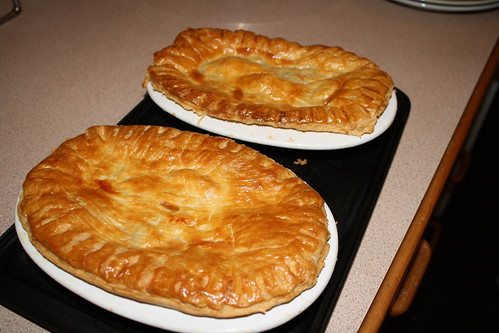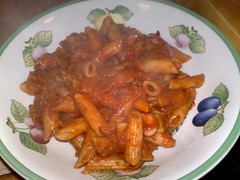One of the things I miss about England is the monthly magazine that almost every supermarket produces. Mostly, these magazines are free (although the ones you pay for are usually well worth it – quite a few Waitrose Food Illustrateds and Sainsbury magazines are still in my collection): they consist of a lot of advertising in various guises but almost always have a good selection of recipes.
This recipe for steak and ale pie is based on one that originally appeared in such a magazine, produced by the now defunct supermarket, Safeway. It’s really easy (so don’t be frightened if you’ve never made a pie before!) but very tasty – make extra and any that doesn’t fit in pie dishes works just as well with some mash as a stew.
The only thing you can’t do here is rush. You want to simmer the mixture for at least an hour and a half so you may prefer to make the filling one day and construct the pie the next …
This take on things produces enough filling to make two (generous) one person pies as well as a more normal sized two person pie.
Start with 750g of diced beef (I used blade), toss it in seasoned flour and brown, in batches, in olive oil over a moderate to high heat. Set the beef to one side, reduce the heat and then add two onions cut into wedges, two peeled, sliced carrots and some whole, but peeled, garlic cloves. I say ‘some’ because you know how much garlic you do or don’t like. Because it’s braised along with the beef it’s not a super strong flavour.
Allow this mix to soften for a few minutes, before adding 375mL of real ale (I used Black Sheep, bought at vast expense from a local bottle shop – but you do need to use a good quality beer with plenty of flavour), 200mL water and 2 tbsp of tomato paste. Bring this to the boil, then add some thyme and bayleaves before covering and simmering for at least 1 &func12; hours. After this time, when the meat is tender, you may wish to increase the heat and remove the lid to thicken up the sauce.
And that, with just a handful of ingredients and hardly any effort, is your pie filling.
Allow the filling to cool and, if necessary, reserve some of the gravy. If you like lots of pastry (and yes, we do!), grease your pie dish(es) and line with shortcrust pastry. Brush the edges of the pastry with egg, add the filling and top with puff pastry, sealing the edges well. Finish by ensuring there’s an air vent (if you have a pie funnel, even better) and glaze with beaten egg.
Bake at 200°C (non-fan) for a good 45 mins (longer if you’ve made one massive pie), until the pie is golden and you can’t wait any longer.
You may wish to serve with vegetables or salad on the side or you may wish to just scoff the rich, warm, pastry goodness!



